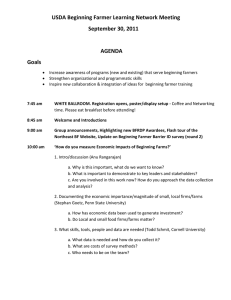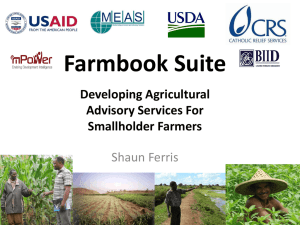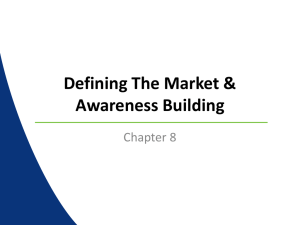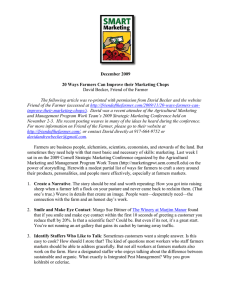IMPROVING THE ACCESS OF SMALLHOLDERS TO AGRICULTURAL SERVICES IN SUB-SAHARAN AFRICA:
advertisement
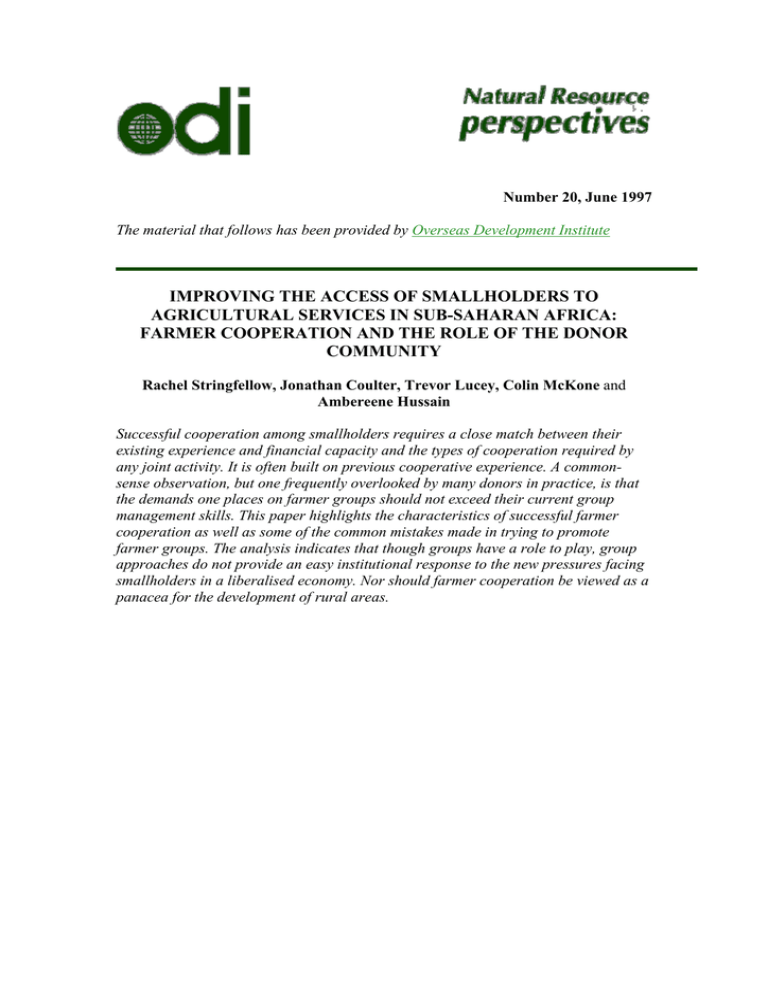
Number 20, June 1997 The material that follows has been provided by Overseas Development Institute IMPROVING THE ACCESS OF SMALLHOLDERS TO AGRICULTURAL SERVICES IN SUB-SAHARAN AFRICA: FARMER COOPERATION AND THE ROLE OF THE DONOR COMMUNITY Rachel Stringfellow, Jonathan Coulter, Trevor Lucey, Colin McKone and Ambereene Hussain Successful cooperation among smallholders requires a close match between their existing experience and financial capacity and the types of cooperation required by any joint activity. It is often built on previous cooperative experience. A commonsense observation, but one frequently overlooked by many donors in practice, is that the demands one places on farmer groups should not exceed their current group management skills. This paper highlights the characteristics of successful farmer cooperation as well as some of the common mistakes made in trying to promote farmer groups. The analysis indicates that though groups have a role to play, group approaches do not provide an easy institutional response to the new pressures facing smallholders in a liberalised economy. Nor should farmer cooperation be viewed as a panacea for the development of rural areas. Introduction Improving smallholder farmers access to agricultural services in Sub Saharan Africa is a central challenge facing governments in the region. Structural adjustment and a commitment to marketbased agricultural development have reduced the direct role of the state in providing services. In most countries publicly financed marketing boards have disappeared and access to unsecured and subsidised credit through government lending institutions is no longer available. Private systems are emerging but there remains a question mark about their ability to fill adequately the gap left by state withdrawal, especially in the shortterm. Policy conclusions • Donors wishing to promote farmer cooperation should refrain from rushing the process of group formation or from overburdening groups with too many or too complex functions. They should avoid providing subsidised credit or grants, but instead encourage farmers to develop their own forms of group organisation, based on an analysis of their own situation and the resources at their disposal. • Assistance should be provided in establishing links to banks, input suppliers and markets. Indeed, smallholders access to markets for high value commodities can be greatly enhanced through group lending activities organised in conjunction with outgrower schemes. The prospect of default is a deterrent to organising such schemes, however, and there is therefore a need to develop new risk-sharing arrangements. • Donors need to adapt their project planning procedures to the nature of farmer-controlled enterprises. Traditional quantitative measures of project achievement may not always be appropriate, especially in the early stages of a project. Farmer cooperation, especially among those having commercial potential, is widely perceived as one mechanism of improving their access to agricultural services. By working together farmers can realise the scale economies of bulk acquisition and enter into more stable relationships with suppliers or traders. By pooling resources to invest in transport or processing operations they can become more active participants in the marketing systems, adding value to their production. In recent years this view has influenced the design of many programmes of assistance to smallholders in Africa to the extent that donors and NGOs have often made group formation a prerequisite for accessing project resources. Additionally, from the donors perspective, there are significant advantages in distributing project resources to groups rather than to individuals, as costs are lower and resources can be disbursed more rapidly. There is growing evidence, however, that projects promoting farmer cooperation do not always lead to the emergence of viable farmer groups. Project evaluations indicate that groups are often formed hastily and with little reference to underlying patterns of social and economic organisation or commitment to cooperative action. As a result many do not survive long and in the worst situation, members negative experiences contribute to undermining future self-help initiatives. In the light of this, policymakers need to reassess the role that groups can play based on a more realistic understanding of what contributes to successful farmer cooperation. What factors contribute to successful farmer cooperation? Matching skills and experience In the first place, there needs to be a close match between the levels of organisational and managerial capacity required by smallholders existing investment enterprises and those required by any future joint activity. Though this might seem an obvious point, there is much evidence to suggest that in practice such a common sense approach has had little influence on project design. In rural Africa, smallholders access to financial resources is likely to be severely constrained and local management experience limited. Yet many projects are designed on the assumption that both can be expanded rapidly. The type of activity to be undertaken will have a major bearing on the management demands made on the group. These may range from coordinating marketing or procurement activities to operating jointly owned assets. Our research suggests that successful groups are more likely to be involved in the former. The skills and experience required to undertake these activities are often less complex than those required to operate a jointly owned piece of processing equipment. Box 1 illustrates this point in relation to fruit drying operations in Uganda. Box 1. Solar fruit drying in Uganda The Kyeirumba Women s Association and the Nakatundu Young Farmers Group both supply the private trading company, the Fruits of the Nile, with sun-dried fruit for export to the UK. Initially both centred their production activities around large group-owned driers which, in the case of the Kyeirumba group, was financed by an NGO. Over time both groups have moved away from group production as they have encountered difficulties in managing the assets efficiently. In place of this members have used their own savings to purchase small, individually operated driers. However, group arrangements have been retained for marketing, as the benefits (lower transport costs, regular deliveries to the trading company, payments by the company into a group account at the bank) outweigh the costs involved. An indication of the success of both groups has been their ability to find a sustainable balance between individual and joint activities. On the other hand, in situations where there is a strong tradition of cooperative working, projects invlving the operation of jointly owned assets can sometimes work. In many parts of Africa processing activities are traditionally undertaken by groups of women and where these are developed sensitively and in line with market opportunities, successful groups have emerged, as the case of palm oil presses in Nigeria illustrates (Fayese, pers. comm.). Donated or subsidised equipment has often had the opposite effect. The introduction of such assets immediately makes demands on a group which are likely to be well beyond its existing capacity, quite apart from undermining a commitment to self-help among its members. Box 2 describes the impact of donated equipment on a marketing project in Zimbabwe. Box 2. Horticultural marketing in Mashonaland East, Zimbabwe The EU has been involved since 1988 with a major project to assist smallholders ivolved in horticultural production in Mashonaland East. Though the project initially focused on improving production and productivity, a second phase emphasised marketing and institutional development. The lack of transport facilities had been identified as a major constraint, leading to the project strategy of forming farmer associations to operate donated trucks. In practice the operation of the associations has been disappointing. Membership of the associations was perceived by farmers simply as a means to receive a free truck. Once acquired, members had little interest in the association and, with no resources of their own invested in the new equipment, viewed it as the responsibility of the donor. This attitude was compounded by the poor performance of the association committees, elected by members to manage the association s marketing activities. These received little training and guidance from the project, despite the complexities of the operations they were involved in. An evaluation of the associations in May 1995 found them to be neither profitable nor sustainable. A relatively less complex activity is group borrowing where members are jointly and severally liable. Whilst it requires a high level of trust among members, and some commitment of time, in return members benefit from improved access to loans. However, not all group borrowing schemes have been successful. Two important factors appear to influence success: groups must be self-selecting if peer pressure is to be effective and they should preferably be producing a high value commodity (for example cocoa or horticultural products for export). The internal dynamics of the group Internal cohesion and a clear memberdriven agenda are central to successful farmer cooperation. Small size, homogeneity and face-to-face contact facilitate these features, as well as accountability among members. Small size and homogeneity are most important where the group activity requires a commitment of financial resources to a shared enterprise. On the other hand, where the group s primary function is to liaise on behalf of its members with a buyer or supplier, larger and more heterogeneous groups may be at less of a disadvantage. However, some donors and NGOs have promoted large groups for marketing or processing because of scale-economies, particularly when they need to acquire vehicles or processing equipment. There is often a trade-off between economies of scale and group cohesion, and group cohesion is a critical factor for sustained success. Previous experience of group or cooperative activity can make an important contribution to the development of cohesive groups. Among women, traditional group processing, savings clubs and petty trading are common. Labour-sharing groups among men and women are also common and a shared religious identity provides the antecedents for many self-help groups. Relations with external agents have an important impact on the development of a group s internal dynamics. Unsurprisingly, where politicians try to manipulate group development through e.g. favoured access to resources, the results contribute little to genuine farmer cooperation. Whatever the source, free or subsidised resources tend to attract people seeking hand-outs and do not necessarily create business opportunities. Strong business rationale and relationships with the private sector Good internal organisational features are no substitute for a strong business rationale, which is thus the third feature of successful group activity. Fundamental to this is the group s successful integration into the wider economy. Two types of relationship operate between farmer groups and external markets. In linkage-independent cases, the group stands alone, providing smallholder members with sufficient market presence to seek out independent relationships with other market intermediaries, for example banks or buyers. A linkage-dependent group depends on a particular outside agency which in effect supervises its activity. This could be, for instance, a private marketing company or a bank which provides working capital to group members. Linkage-independent groups offer independence and autonomy. Their success depends primarily on the skills and experence of members. Linkagedependent groups not only rely on these, but also on the support of the company or bank to which they are linked and which has a vested interest in their survival. Whilst this potentially places such a group in a weak bargaining position, it can provide members with many of the benefits of farmer cooperation in return for a much lower commitment of managerial and entrepreneurial skill than that required by independent groups. Box 3 provides examples of linkage-dependent groups in Ghana and Uganda. In the past donors and NGOs have tended to promote independent farmer groups, often organised into federations and confederations, rather than links between groups of farmers and banks or private companies. Whilst some donors and NGOs are continuing this approach, others are setting up programmes which promote linkages between groups of farmers and the private sector. What role should donor agencies and NGOs play in promoting farmer cooperation? What donors should not do To avoid undermining the process of successful group development donors should: • • Box 3. Linkage dependent groups in Ghana and Uganda Barclays Bank and cocoa farmers in Ghana Since 1988 Barclays Bank of Ghana has been lending to groups of cocoa farmers through the existing network of cocoa primary societies operating under the Produce Buying Company. Applicants for the scheme are screened by the society s committee and by the bank s agricultural officer. Successful applicants form groups of between 10 and 15 members which are jointly liable for the repayment of all loans made to the group. Members also contribute to a group security fund deposited with the bank. Non-payment by any member of the group automatically disqualifies the other members from the scheme the following year. Liberalisation of cocoa marketing has created a new challenge for the scheme as the proliferation of alternative marketing outlets has made it harder to monitor farmers to ensure repayment. But despite this, in early 1995-96 Barclays had almost 3,500 borrowers and is achieving a recovery rate of 99.6%. UVAN Ltd and groups of associations of vanilla farmers in Uganda UVAN Ltd is a private company which buys, processes and exports vanilla. It works with groups of farmers organised into associations. This facilitates the company s operations as the associations play a role in selecting suitable farmers for participation in the company s lending programme, recovering loans and bulking up and assessing the quality of vanilla for purchase. They also mobilise farmers to attend training programmes provided by the company and negotiate with the company on the price paid for vanilla each season. The associations are registered under the register of companies. Each association agrees on common objectives and rules and UVAN Ltd provides some secretarial support and legal assistance. Each association has a voluntary executive Refrain from rushing the committee and members are required to pay process of group formation. If subscriptions. Benefits to members through donors drive the process, e.g. by membership of the Association are improved access setting numerical targets for to extension services; timely marketing of produce number of groups formed , and immediate cash payments; a collectively negotiated price for vanilla; and access to financial responsibility is taken away services. from the group members. Not require groups to undertake many or complex functions, especially early on and in projects involving the joint ownership of assets. • Avoid providing subsidised credit or grants, especially in the initial stages of group development. Those who work in donor organisations will know that this is easier said than done. On the one hand, there are often powerful pressures to identify projects and disburse funds. On the other, project planning and review mechanisms do not generally allow changes to be made in response to new findings, so that once objectives and targets are fixed, achieving them tends to become an end in itself. To overcome this situation will require profound changes in the philosophy and operations of the organisations themselves. What donors should do Good practice in the field suggests that the best approach to assist groups of farmers is by encouraging them: • • • To analyse arrangements with regard to market access. To consider ways of improving this. To implement their preferred option, and invest their own resources in the enterprise. This approach has a much higher likelihood of producing groups controlled by members, and the types of activity proposed are mre likely to be consistent with what local people feel they can achieve and with previous experience of group cooperation. Outside support should be provided by the donor at the community s request, and might involve the provision of training, knowledge and contacts to help the community identify and implement its preferred option. Training may involve literacy, leadership and organisational skills as well as technical training to improve the quality of marketed production, for example. Requests for financial resources should be treated with caution, and where needed, groups should be encouraged to approach banks or similar specialised institutions. The promotion by donors of links with the private sector can bring benefits to smallholders in terms of access to finance, inputs and new markets. The promotion of autonomous groups is likely to require a higher investment in training and capacity building than that required by linkage-dependent groups. On the other hand, even these groups will require sufficient technical and business training to allow them to enter into mutually beneficial agreements with buyers. Box 4 provides examples of projects in Africa which appear to be applying this approach. Box 4. A client-led and market-oriented approach to promoting farmer cooperation The Kafo Project, Sikasso Region, Mali Funded by the World Bank, the Kafo Project is promoting agricultural diversification in an area traditionally dominated by cotton and where the marketing of other comodities is weak. The project is involved in a range of activities, many of which involve farmer cooperation, including training to improve the quality of what is marketed; support to producer associations, linking them directly with buyers; the dissemination of market information to producers and the linking of groups of smallholders to financial institutions. Cooperative League of the United States (CLUSA) Together with local partners, CLUSA has engaged in long-term farmer-group programmes in various countries of Africa, notably Niger, Mali, Cape Verde and Mozambique. The approach has involved a heavy emphasis on functional literacy training. Armed with this tool and with CLUSA s advisory support, farmers identify their own business activities, and develop them according to their own wishes. This will typically involve group members drawing up business plans, seeking bank funding, finding buyers, and negotiating input supply contracts. Intermediate Technology Development Group, Zimbabwe This NGO is working with farmers in some of the driest areas in the Chivi district of Zimbabwe. Farmers are encouraged to form groups to analyse their problems together. No material assistance is given other than training in problem analysis and soil and moisture conservation techniques. In many groups traditional forms of leadership have re-emerged. Marketing activities are a priority for the groups who see the opportunity to market cash crops as a way out of subsistence farming. A number of groups have established marketing links with buyers in the towns, including Chibuku breweries which purchases sorghum for beer making. Policy issues relevant to a participatory and market-oriented approach The relatively recent emergence of this approach to rural enterprise development, coupled with limited experience in the field, leaves a number of key policy and programme design issues open to further discussion. One relates to the role of publicly funded activities within a private sector framework. To what extent should public resources be used to promote market integration if the beneficiaries are not just smallholders but large companies as well? If a company believes that it is in its interests to work with smallholders, is it not reasonable to expect that it will get on with developing these links itself? One area where assistance might be justified is in developing and piloting new institutional arrangements between companies, banks and smallholders which are mutually acceptable in terms of risk-sharing and the distribution of benefits. Liberalisation in Africa has created many new export opportunities for private companies, but in many countries agribusiness is finding it difficult to develop supply networks involving smallholders. Zambia and Zimbabwe s burgeoning horticultural industries are almost entirely supplied by commercial farmers. If smallholders are to be important suppliers, they need working capital or input loans, but agribusiness is reluctant to provide such support because of poor credit discipline, spurred by debt forgiveness in past lending programmes. Box 5 illustrates the problem in relation Box 5. Cracking the nut of working to an established horticultural export capital company in Zimbabwe. Assistance could also be provided directly to groups of farmers in the form of training, especially in organisational and business skills, in order to improve their ability to negotiate effectively with contracting companies. Responsibility for the provision of training services needs careful consideration. If a donor does this directly, through its own project staff, then when the project finishes, the institutional capacity to continue training disappears with it. A more sustainable approach is likely to involve an established institution. In some countries this might be the farmers union where this has a wide membership, for example the Zimbabwe Farmers Union. In some cases, the government agricultural extension system might be involved, but inappropriate motivation and outlook may present problems. Hortico is a commercial horticultural company about 40 km outside Harare and is involved in growing high value crops for export. The vast majority of production comes from the company s outgrowers who are commercial farmers in the area. But the company has also assisted some smallholders in overhead irrigation and trained them in crop production, working closely with government extension officers. Until recently, it has also provided working capital, making deductions for loans from final payments. The company is presently considering a new business venture to increase the number of its smallholder growers from 200 to 3,000. The company anticipates providing fixed assets (transport, cold stores etc) as well as training and supervision, but it cannot provide working capital to an expanded number of growers given the high risks involved. According to the company s Financial Director, this represents a major problem as smallholders do not have the necessary security to get bank loans and even the Agricultural Finance Corporation, which used to be an easier source of financing for smallholders, will no longer make unsecured loans. In his own words, cracking the working capital nut is the major challenge facing the company. Given that individual smallholders do not have assets against which loans can be secured, one way forward may be to develop group lending among smallholders with the group putting up a security fund of sufficient value to deter prospective defaulters. Marketing issues tend to lie outside the responsibility of extension agents and when this is not the case they may be required to put over official messages rather than promote a participatory process. If extension agents are to be used, they are likely to require extensive training. Another alternative might be to work through local NGOs with an established presence in the project area. The longterm financing of training services is another issue. To be sustainable beyond the life of any donor-assisted project, cost recovery needs to be considered from the outset. The degree to which any programme of this kind can or should become selffinancing is a closely related issue. Finally, donors need to adapt their project planning procedures to the nature of cooperative enterprises. At least in the early stages, traditional quantitative measures of project achievement, for example the number of groups established or the number of farmers benefited, will not be appropriate. Instead, there may be a need for a pilot or even research phase in which different approaches to cooperation can be tested and validated. Where this leads to effective forms of farmer cooperation, other farmers may well emulate what they see, making dissemination to a large extent spontaneous. Subsequent project activities can support this process and encourage long-term sustainability. Conclusions The research on which this paper was based was funded by ODA (now DFID) and jointly undertaken by NRI and the Plunkett Foundation (project leader: J. Coulter, NRI). Fieldwork was undertaken during 1995 and 1996 in Ghana, Uganda, Zimbabwe, Mali and Burkina Faso. Separate reports are available on each country case study from the Plunkett Foundation and a Synthesis Report is also available. The benefits of farmer cooperation are most likely to be realised Jonathan Coulter can be contacted at: The Natural Resources Institute, The University of Greenwich, Central Avenue, Chatham when donors adopt an Maritime, Kent ME4 4TB, UK Internet: http://www.nri.org approach which is both Tel: +44 (0)1634 880088 Fax: +44 (0)1634 880066/77 participatory and market Trevor Lucey, Colin McKone and Ambereene Hussain can be contacted at: oriented. A number of The Plunkett Foundation, 23 Hanborough Business Park, Long Hanborough, Oxfordshire OX8 8LH, UK. Tel: +44 (0)1993 883636 Fax: +44 (0)1993 883576 projects in Africa are adopting this approach Rachel Stringfellow can be contacted c/o Jonathan Coulter at the Natural Resources Institute and central to their (see above) success is the promotion of effective links between groups of smallholders and the private sector. Natural Resource Perspectives present accessible information on important development issues. Readers are encouraged to quote from them for their own purposes or duplicate them for colleagues but, as copyright holder, ODI requests due acknowledgement. The Editor welcomes readers comments on this series. Design: Peter Gee Administrative Editor: Alison Saxby Series Editor: John Farrington ISSN: 1356-9228 ©Copyright:Overseas Development Institute 1997 Overseas Development Institute Portland House Stag Place London SW1E 5DP, UK Telephone +44 (0)171 393 1600 Fax +44 (0)171 393 1699 Email: nrp@odi.org.uk Overseas Development Institute Home Page
